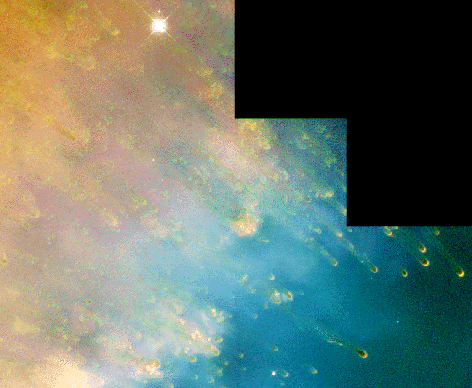Credit & Copyright: R. O'Dell and K. Handron
(Rice University),
NASA
Explanation:
While exploring the inner edge of the
Helix Nebula with the Hubble Space
Telescope's
Wide Field Planetary Camera 2, astronomers were able
to produce this striking image - rich in details of an exotic environment.
This
planetary nebula, created near
the final phase of a sun-like star's life,
is composed of tenuous shells of gas ejected by the hot central
star. The atoms of gas, stripped of electrons by ultraviolet radiation
from the central star, radiate light at characteristic
energies allowing specific chemical elements to be identified. In
this image,
emission from nitrogen is represented as red,
hydrogen emission as green, and oxygen as blue.
The inner edge of the nebula (the direction to the central star)
is toward the bottom right. Clearly visible close to the
inner edge are finger shaped "cometary knots".
1999 2000 2001 2002 2003 2004 2005 2006 2007 2008 2009 2010 2011 2012 2013 2014 2015 2016 2017 2018 2019 2020 2021 2022 2023 2024 2025 |
Yanvar' Fevral' Mart Aprel' Mai Iyun' Iyul' Avgust Sentyabr' Oktyabr' Noyabr' Dekabr' |
NASA Web Site Statements, Warnings, and Disclaimers
NASA Official: Jay Norris. Specific rights apply.
A service of: LHEA at NASA / GSFC
& Michigan Tech. U.
|
Publikacii s klyuchevymi slovami:
Planetarnaya tumannost' - Tumannost' Ulitka - Evolyuciya zvezd
Publikacii so slovami: Planetarnaya tumannost' - Tumannost' Ulitka - Evolyuciya zvezd | |
Sm. takzhe:
Vse publikacii na tu zhe temu >> | |
